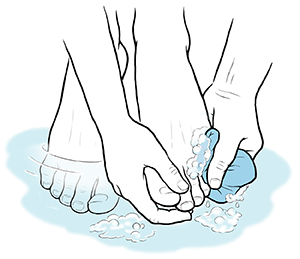You have been diagnosed with pressure injuries of the foot related to diabetes. Diabetes is a disease that makes it very hard to control your blood sugar. One dangerous complication of diabetes is a higher risk of having serious foot problems. Diabetes can cause nerve damage. This means that you might not feel a sore on your foot. Even minor wounds can easily get infected when you have diabetes. If not treated, these infections can be life-threatening. Infections that settle in the bones can also spread all over your foot and leg. In some cases, amputation (removal) is needed.
Your doctor wants you to practice good diabetic foot care. This can help make sure that hot spots, small cracks, or sores are treated before they get infected. If you do have an infection, medicines may be prescribed. Follow the tips on this sheet to take better care of your feet.
After surgery
If you have had surgery, change your dressings as directed by your doctor. This helps prevent infection. Regular wound care helps keep your foot free of infection and aids healing:
-
Wash your hands with soap and clean, running water for at least 20 seconds.
-
Put on disposable gloves if your foot is infected.
-
Gently remove the old dressing and discard it in a plastic bag.
-
Take off the gloves.
-
Wash your hands again.
-
Put on new gloves.
-
Clean and dress the wound as directed by your doctor.
-
Put any used items or trash in a plastic bag before placing in a trash can.
-
Put sharp objects in a puncture-proof container (sharps box).
Daily foot check
Here is what you can do:
-
Check your feet every day. Use a mirror to look at the bottom of your feet. Make sure you also check between your toes. This helps you to catch small skin changes before they get infected. Or before they turn into bigger problems, such as pressure sores.
-
Call your doctor right away if you find any problems. These include hot spots, red streaks, swelling, cracks, sores, injuries, blisters, or foreign objects in your foot.
-
Before putting on shoes, check the soles and insides. Check for pebbles or splinters. Remove any you find. They could break the skin or put added pressure on your feet.
Foot care
Suggestions include:
-
Wash your feet every day. Use water that is not hot (lukewarm) and mild soap. Wash between your toes.
-
Use a soft towel to dry your feet well. It is very important to dry well between your toes. Pat feet gently. Don't rub.
-
Use a moisturizer to keep the skin smooth. This is very important for your heels. If skin is cracked, talk with your doctor. Ask how to treat it. Don't put lotion between your toes. This can lead to fungal infections.
-
Before putting on your shoes, check your socks. Make sure they are not bunched up. Also make sure they don't have folds or creases in them. Even little bumps from bunched socks can cause a serious foot wound. Think about wearing socks without seams.
-
Talk with your doctor before treating calluses, corns, or bunions. Never treat them on your own.
-
To prevent ingrown toenails, cut toenails straight across. Talk with your doctor if you have trouble cutting your toenails.
-
Try to keep your feet from getting too hot or too cold.
-
Stay away from rough surfaces. Or surfaces with sharp objects.
-
Don't soak your feet. This can make your skin dry.
-
Don't wear shoes that are too tight or uncomfortable. Talk with your health care team if you need help finding shoes that fit well. Shoes made specifically for people living with diabetes are available.
-
Don't test bath water temperature with your feet if you have less feeling. Use your hands instead.
-
Never go barefoot, even in your house.
-
Set a time every day to check your feet for sores or pressure areas. Use a mirror to check the bottoms of your feet.
-
Follow your doctor’s instructions about walking and other activity. There may be some restrictions depending on the condition of your feet. You may need special shoes or inserts. These help take the pressure off the ulcers.
-
Take all medicines exactly as directed.
Follow-Up
Your doctor will look at your feet on a regular basis. Your doctor may refer you to a special wound-care center for treatment.
When to contact your doctor
Contact your doctor if:
-
You have a fever of 100.4°F (38°C) or higher, or as directed by your doctor.
-
You have redness, swelling, or pain in the foot, or surgical incision.
-
You have new sores or areas of concern on your feet
-
You have numbness or tingling in any part of your foot.
-
You have chills, light-headedness, or fainting.
-
There is drainage or bad smell from wounds, incision, or swollen areas.
-
An incision breaks open or bleeds a lot.


